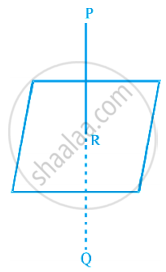Advertisements
Advertisements
प्रश्न
Find the image of the point having position vector `hati + 3hatj + 4hatk` in the plane `hatr * (2hati - hatj + hatk)` + 3 = 0.
उत्तर
Let the given point be P`(hati + 3hatj + 4hatk)` and Q be the image of P in the plane `hatr * (2hati - hatj + hatk)` + 3 = 0 as shown in the figure.

Then PQ is the normal to the plane.
Since PQ passes through P and is normal to the given plane
So the equation of PQ is given by `vecr = (hati + 3hatj + 4hatk) + lambda(2hati - hatj + hatk)`
Since Q lies on the line PQ, the position vector of Q can be expressed as `(hati + 3hatj + 4hatk) + lambda(2hati - hatj + hatk)`
i.e., `(1 + 2lambda)hati + (3 - lambda)hatj + (4 + lambda)hatk`
Since R is the mid point of PQ, the position vector of R is
`([(1 + 2lambda)hati + (3 - lambda)hatj + (4 + lambda)hatk] + [hati + 3hatj + 4hatk])/2`
i.e., `(lambda + 1)hati + (3 - lambda/2)hatj + (4 + lambda/2)hatk`
Again, since R lies on the plane `vecr * (2hati - hatj + hatk)` + 3 = 0
We have `{(lambda + 1)hati + (3 - lambda/2)hatj + (4 + lambda/2)hatk} * (2hati - hatj + hatk) + 3` = 0
⇒ λ = –2
Hence, the position vector of Q is `(hati + 3hatj + 4hatk) - 2(2hati - hatj + hatk)`
i.e. `-3hati + 5hatj + 2hatk`.
APPEARS IN
संबंधित प्रश्न
Name the octants in which the following points lie:
(1, 2, 3), (4, –2, 3), (4, –2, –5), (4, 2, –5), (–4, 2, –5), (–4, 2, 5),
(–3, –1, 6), (2, –4, –7).
The x-axis and y-axis taken together determine a plane known as_______.
Three vertices of a parallelogram ABCD are A (3, –1, 2), B (1, 2, –4) and C (–1, 1, 2). Find the coordinates of the fourth vertex.
Name the octants in which the following points lie:
(4, –3, 5)
Name the octants in which the following points lie:
(–5, –4, 7)
Name the octants in which the following points lie:
(–5, –3, –2)
Find the image of:
(–5, 4, –3) in the xz-plane.
Find the image of:
(–5, 0, 3) in the xz-plane.
Planes are drawn through the points (5, 0, 2) and (3, –2, 5) parallel to the coordinate planes. Find the lengths of the edges of the rectangular parallelepiped so formed.
Determine the point on z-axis which is equidistant from the points (1, 5, 7) and (5, 1, –4).
Verify the following:
(–1, 2, 1), (1, –2, 5), (4, –7, 8) and (2, –3, 4) are vertices of a parallelogram.
Find the locus of the points which are equidistant from the points (1, 2, 3) and (3, 2, –1).
Write the length of the perpendicular drawn from the point P(3, 5, 12) on x-axis.
What is the locus of a point for which y = 0, z = 0?
The ratio in which the line joining (2, 4, 5) and (3, 5, –9) is divided by the yz-plane is
Find the direction cosines of the line passing through the points P(2, 3, 5) and Q(–1, 2, 4).
If a line makes angles α, β, γ with the positive directions of the coordinate axes, then the value of sin2α + sin2β + sin2γ is ______.
Find the equation of the plane through the points (2, 1, 0), (3, –2, –2) and (3, 1, 7).
If a variable line in two adjacent positions has direction cosines l, m, n and l + δl, m + δm, n + δn, show that the small angle δθ between the two positions is given by δθ2 = δl2 + δm2 + δn2
O is the origin and A is (a, b, c). Find the direction cosines of the line OA and the equation of plane through A at right angle to OA.
Find the equation of the plane through the points (2, 1, –1) and (–1, 3, 4), and perpendicular to the plane x – 2y + 4z = 10.
Find the equation of the plane which is perpendicular to the plane 5x + 3y + 6z + 8 = 0 and which contains the line of intersection of the planes x + 2y + 3z – 4 = 0 and 2x + y – z + 5 = 0.
Show that the points `(hati - hatj + 3hatk)` and `3(hati + hatj + hatk)` are equidistant from the plane `vecr * (5hati + 2hatj - 7hatk) + 9` = 0 and lies on opposite side of it.
If l1, m1, n1 ; l2, m2, n2 ; l3, m3, n3 are the direction cosines of three mutually perpendicular lines, prove that the line whose direction cosines are proportional to l1 + l2 + l3, m1 + m2 + m3, n1 + n2 + n3 makes equal angles with them.
The sine of the angle between the straight line `(x - 2)/3 = (y - 3)/4 = (z - 4)/5` and the plane 2x – 2y + z = 5 is ______.
The plane 2x – 3y + 6z – 11 = 0 makes an angle sin–1(α) with x-axis. The value of α is equal to ______.
The vector equation of the line `(x - 5)/3 = (y + 4)/7 = (z - 6)/2` is ______.
The vector equation of the line `(x - 5)/3 = (y + 4)/7 = (z - 6)/2` is `vecr = (5hati - 4hatj + 6hatk) + lambda(3hati + 7hatj - 2hatk)`.
